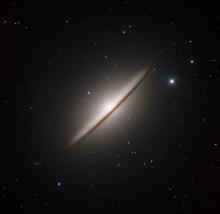Listen to today's episode of StarDate on the web the same day it airs in high-quality streaming audio without any extra ads or announcements. Choose a $8 one-month pass, or listen every day for a year for just $30.
You are here
Galactic UFO
A UFO has been spotted in a galaxy more than two billion light-years away — an ultra-fast outflow. It’s a “wind” created by a disk of hot gas around a supermassive black hole in the galaxy’s heart. And soon, it may sweep away all the gas and dust for making new stars.
PDS 456 is in Serpens Cauda — the tail of the serpent. The constellation is a third of the way up the southeastern sky at nightfall. The galaxy is far too faint to see without a telescope.
Even so, it’s the brightest “quasar” within billions of light-years. It’s powered by a black hole that’s a billion times the mass of the Sun. Gas and dust fall toward the black hole, forming a wide disk around it. Material in the disk is heated to extreme temperatures, so it emits a lot of radiation and charged particles. They produce the UFO — a heavy wind that blows at a quarter of the speed of light, and carries as much energy as a trillion Suns.
The wind blows in every direction. And it acts like a galaxy-wide broom — it sweeps gas and dust away from the galaxy’s core. Right now, it’s pushing enough material to make 250 million stars as heavy as the Sun. And in fact, as that material piles up, clumps of it do give birth to some new stars.
That won’t be the case for long, though. At the current rate, the wind from the black hole will sweep all the gas and dust out of the galaxy in a few million years — leaving PDS 456 unable to make any more stars.





